- Share
Manufacturing or Degree-Intensive Labor Markets: Where Do the Children of Non-College Graduates Earn More Degrees?
Manufacturing employment has declined since the 1970s, while the number of jobs requiring a college degree has risen. The shift has reshaped the environment in which many young people grow up and pursue their educations, potentially affecting the level of education they attain. This analysis uses the National Longitudinal Surveys of Youth to investigate the relationship between industrial composition and the educational attainment of children whose parents have only a high school education or less. The results show that the educational attainment of these youths is correlated with the region’s industrial mix, though in ways that may seem somewhat surprising.
The views authors express in Economic Commentary are theirs and not necessarily those of the Federal Reserve Bank of Cleveland or the Board of Governors of the Federal Reserve System. The series editor is Tasia Hane. This paper and its data are subject to revision; please visit clevelandfed.org for updates.
The recent national discussion of income inequality has raised awareness of the millions of Americans who have not been able to achieve upward mobility. For most young people, matching or exceeding their parent’s standard of living requires that they complete high school or college. The environment in which young people grow up and pursue their educations has been radically reshaped by the change in the mix of industries in our economy since 1970. Specifically, the percent of adults employed in manufacturing has been declining while the shares of industries that employ more college graduates have been increasing. This raises the question whether children whose parents do not have college degrees are more or less likely to attain degrees if they grow up in a labor market that has lower shares of manufacturing employment. Likewise, when the children of nondegreed parents grow up surrounded by degree-intensive industries, do those children climb to the next rung of the educational ladder, or are they left behind?
Using the National Longitudinal Surveys of Youth (NLSY), this analysis documents the relationship between industrial composition and the educational attainment of children whose parents have only a high school education or less. The results show that the educational attainment of a region’s youth is correlated with the region’s industrial mix. Contrary to popular belief, students who grow up in regions where manufacturing employs a larger share of the workforce are more likely to finish high school and college than those who grow up in regions without a high manufacturing share. If we compare regions that specialize in college-degree-intensive industries, such as health care, with regions that do not specialize in these industries, we see a pattern that suggests continued inequality. In degree-intensive regions, cohorts of children born to non-college-graduate parents have higher shares of both high school dropouts and college graduates.
Changing Industrial Composition
There has been growth in college-degree-intensive industries, which can be defined as industries in which an above-average share of the employees hold college degrees.1 The largest degree-intensive industries include healthcare, education, finance, insurance, and real estate. Several non-degree-intensive industries have experienced declines in their share of jobs, but the manufacturing sector is of particular interest because it has historically paid high wages to workers without college degrees.
Figure 1 illustrates the national trends in degree-intensive and manufacturing employment. The third category, other non-degree-intensive, includes all other employment. Over the past four and a half decades, the share of jobs in college-degree-intensive industries has increased from 25 percent to 34 percent, while the share of jobs in manufacturing has declined from 25 percent to 12 percent. Some observers have celebrated this “rust belt to tech belt” transition.2 More recently, however, the “economic inclusion” movement has raised concerns that the growing industries do not provide enough work opportunities or middle-class incomes for people without college degrees.3
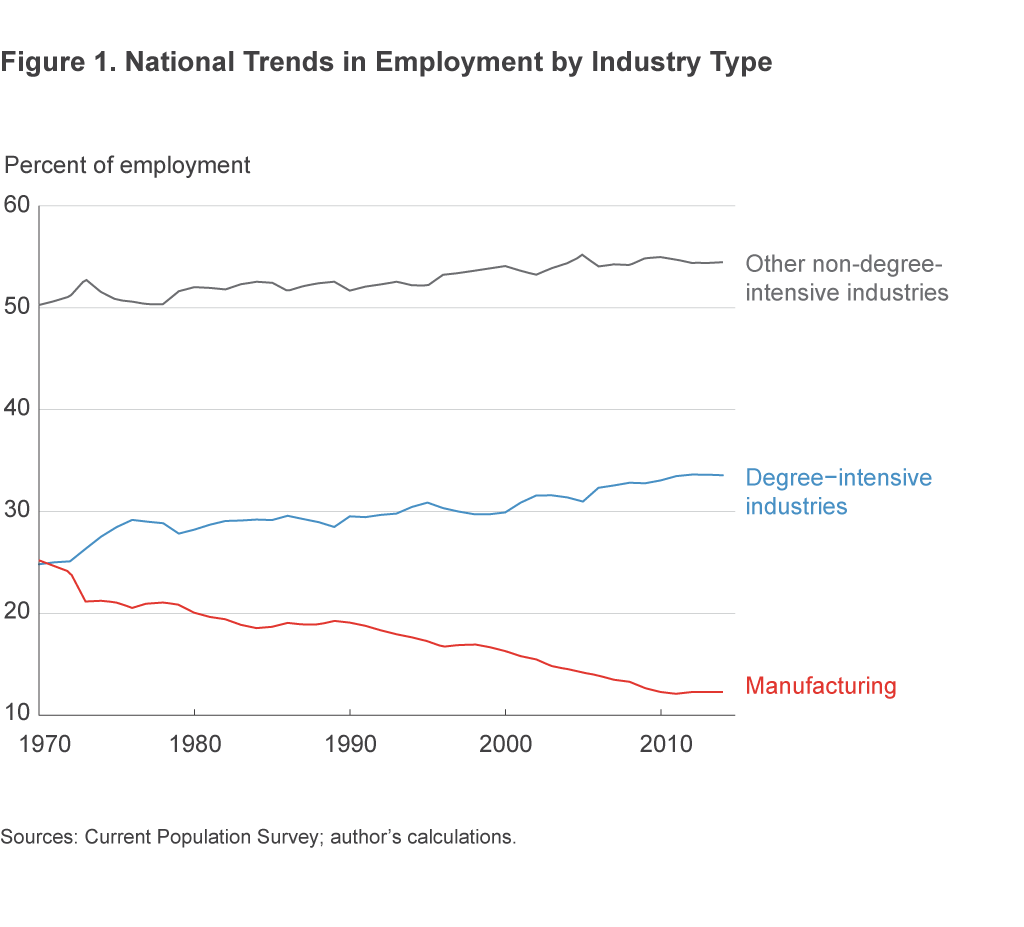
Among large metropolitan areas, Providence, Rhode Island, has had the most pronounced transition from manufacturing to degree-intensive industries. In 1980, 40 percent of workers in the Providence metro area worked in manufacturing and 25 percent worked in degree-intensive fields. By 2014, manufacturing had dropped to just 11 percent, and degree-intensive jobs had risen to 47 percent. Similar transitions have occurred in Milwaukee, Indianapolis, Cleveland, Pittsburgh, and Philadelphia.
Some metro areas are now dominated by degree-intensive industries, while others maintain a share of manufacturing employment that is above the national average. For example, at one extreme, 68 percent of jobs in Washington DC, are in degree-intensive fields and only 3 percent are in manufacturing. At the other extreme, in Detroit, Michigan, 17 percent of workers still work in manufacturing, while 40 percent work in degree-intensive industries. Do the children of parents without a college degree have more advantages supporting their educational attainment in the Providence of today than in the Providence of 1980? Are these children better off today in Washington DC or in Detroit?
Industrial Composition and Education
There are many reasons that a region’s current industrial mix might influence the educational attainment of the local youth. First, the industrial mix of the region could affect the perceived returns to education. We would expect young people to invest more time and money in gaining an education if the returns to education are higher. But if manufacturing jobs pay middle-class wages to people without high school degrees or with only high school degrees, the premium that students could gain by earning their secondary and postsecondary degrees shrinks. Even more immediately, high-paying manufacturing jobs create an opportunity cost to staying in school. The wages that prevail for high school and college graduates in regions with high shares of jobs in degree-intensive industries will also influence educational returns and opportunity costs.
Another way in which the industrial mix could affect educational outcomes in a region is through tax revenues. If the manufacturing or degree-intensive sectors support state and local tax revenue more than other industries would, that could result in higher spending by school districts and higher subsidies of public universities. Either of these added investments could increase educational attainment among the region’s youth. Similarly, if parents without college degrees are able to earn higher incomes and accumulate more wealth in some labor markets, they should be able to invest more in their children’s education.
Other possible routes of influence involve the effects of regional employment options on family structure, networking opportunities, and exposure to role models. Single parents usually cannot invest as much time or money in children as dual-parent households. If lower incomes and more frequent unemployment make nondegreed couples less likely to stay together, the loss of manufacturing jobs could depress their children’s school performance by tilting the family structure toward single parenthood. Along with educational inputs, parents can provide both a role model and a career network for their children. An unskilled parent working in a hospital, for example, may encourage his or her child to pursue a career in medicine. Parents employed in manufacturing might find work for their teenager at a factory and thereby increase the teen’s perceived opportunity cost.
Even if a student’s parents are not employed in a degree-intensive industry, it is likely that the student will gain information about educational opportunities from college graduates in the community. The child of a high school graduate growing up in a college town, for example, is likely to view attending college as the normal thing to do after finishing high school.
A final reason that we might see a positive relationship between the degree intensity of local industries and the educational attainment of local youth is geographic sorting of their parents by ability. Among parents without college degrees, there is a wide range of academic abilities. If the more able parents can earn higher wages in regions with more degree-intensive industries, they may migrate to these regions. The children of these parents should be more likely to finish high school and college if the parents are able to pass on their higher abilities to some extent.
The Data
Although the role of deindustrialization is often discussed in the debates about intergenerational mobility, relevant empirical evidence is meager because some uncommon data are needed. Many surveys record respondents’ current location and educational attainment. But to measure the impact of the local industrial mix, we must know where the person was when they decided whether to finish high school and whether to apply to college. If we want to focus on the children of parents without a college degree, we also need to know the parent’s educational attainment, which is rarely asked.
Fortunately, the National Longitudinal Surveys of Youth (NLSY) provide the needed data.4 There are three surveys: The first started with a nationally representative sample of people who were between the ages of 14 and 22 in 1979. They were asked background questions, including their parents’ education level, and reinterviewed annually or biannually. A second survey was started that follows all the children born to the women who were respondents in the 1979 survey. A new nationally representative sample of young people was created in 1997 and followed after that. I refer to these below as the 1979 survey, the children’s survey, and the 1997 survey.
The county of residence is recorded for each NLSY respondent at each interview. Using these data, it is possible to merge in various measures of the local labor markets that the respondents were living in at age 17. The labor market data are from the Current Population Survey.
To assess the relationship between the local industrial composition and educational attainment, I categorize the percentage of employees in the local labor market who are working in degree-intensive industries or manufacturing. I then calculate the high school and college attainment for the children of parents who do not have a college degree. Respondents are excluded from the high school calculations if they are not at least 19 years old at the time of the most recent interviews in 2012. The college attainment calculations are limited to respondents 25 and over.
Results, High School Attainment
For the 1979 survey, respondents living in labor markets with high shares of jobs in degree-intensive industries are not more likely to graduate from high school (figure 2). Graduation rates are below 90 percent for those in labor markets with above-average degree-intensive shares, but they are 2 to 5 percentage points higher if degree-intensive employment is below average. For the children’s survey and the 1997 survey, the relationship between degree-intensive jobs and high school attainment does not appear as strong, but it is still at least mildly negative.
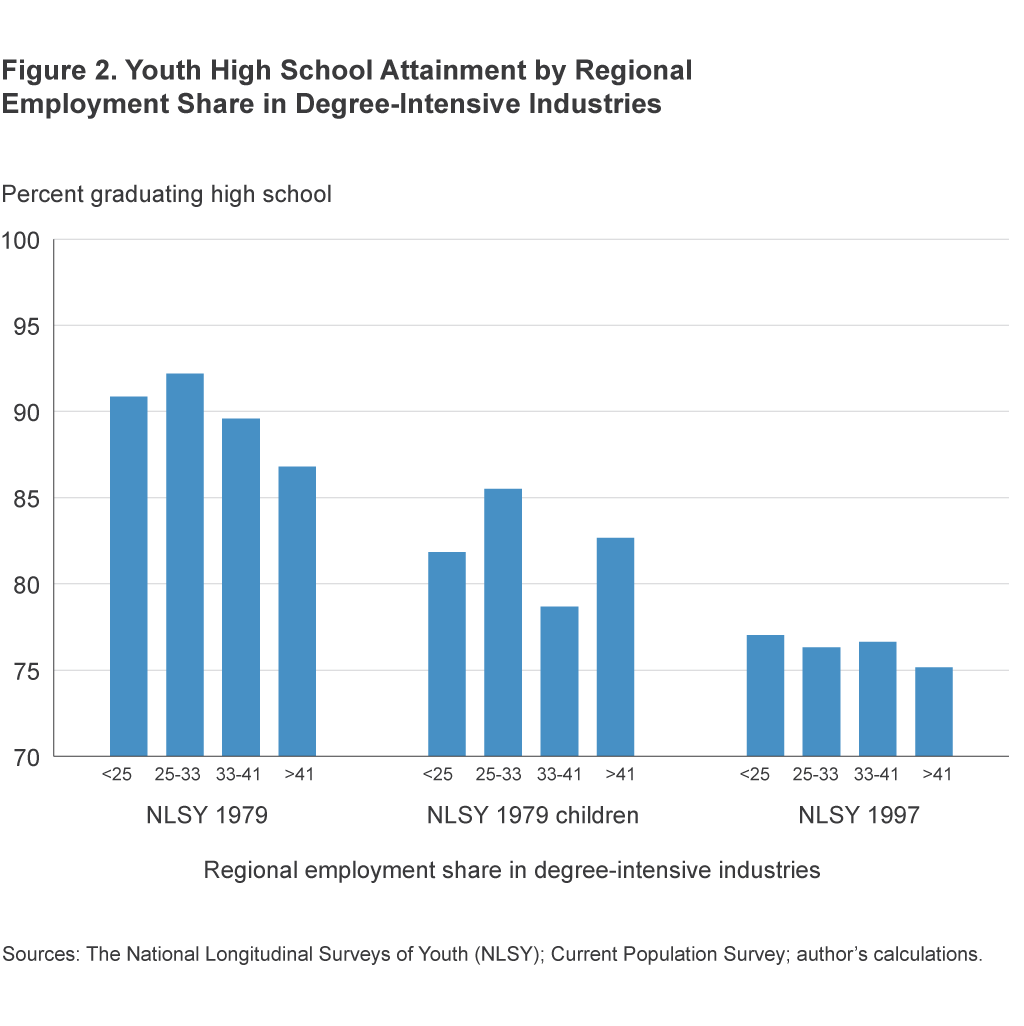
When the survey respondents are sorted by the shares of manufacturing employment that they were exposed to, the patterns are different (figure 3). The 1979 respondents show no negative relationship between manufacturing and high school graduation, but no clearly positive relationship either. For the children’s survey, each higher quartile of manufacturing employment is associated with a higher high school attainment rate, with a 4 percentage point difference from the lowest to highest quartile. The 1997 respondents also appear to have higher high school attainment if they are living in labor markets with higher shares of manufacturing.
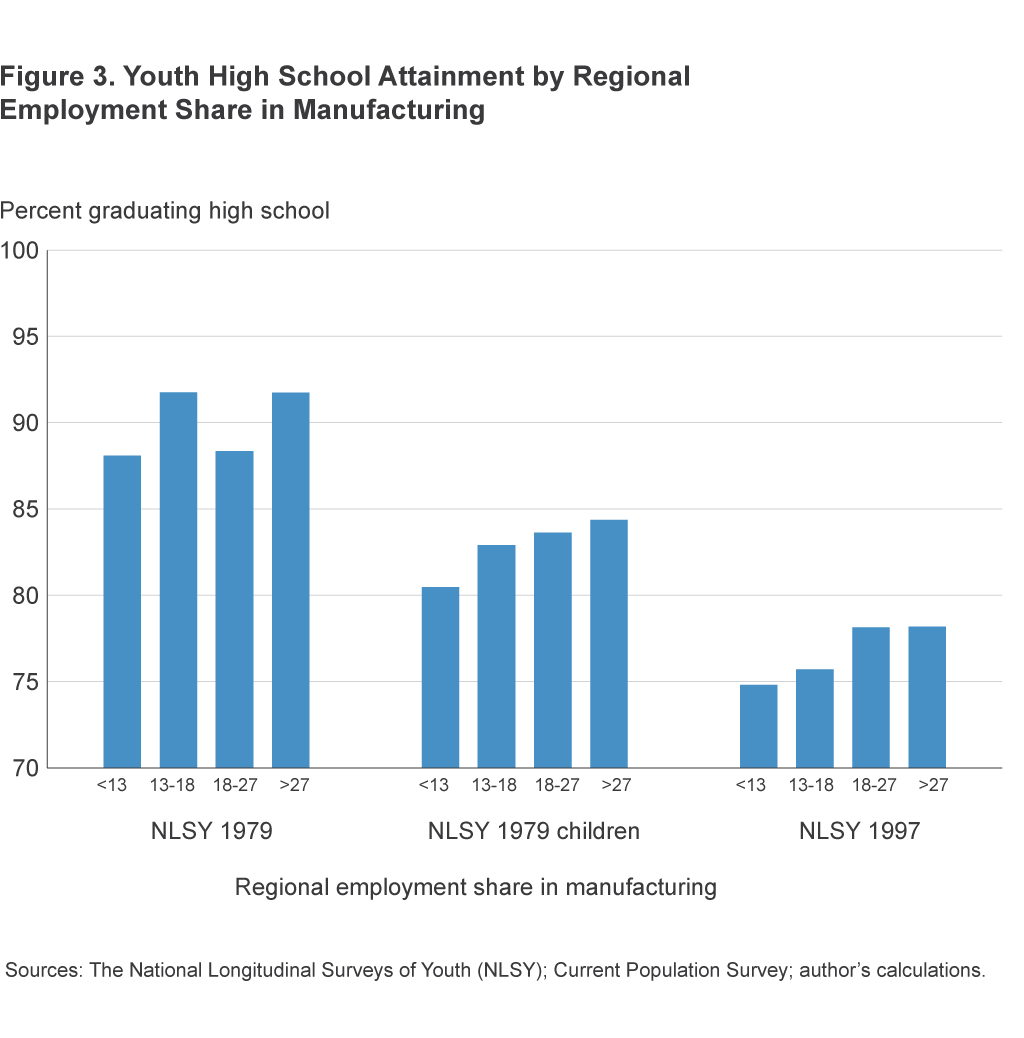
Results, College Attainment
When we consider the college attainment of respondents whose parents did not complete college, industrial composition seems to matter more for young people who finished their schooling after 1990 than it did for young people in the early 1980s. For the children’s survey and the 1997 samples, almost every increase in degree-intensive or manufacturing share is associated with higher college attainment, while for the 1979 respondents, there is no consistent relationship between the share of degree-intensive or manufacturing jobs and college attainment (figures 4 and 5).
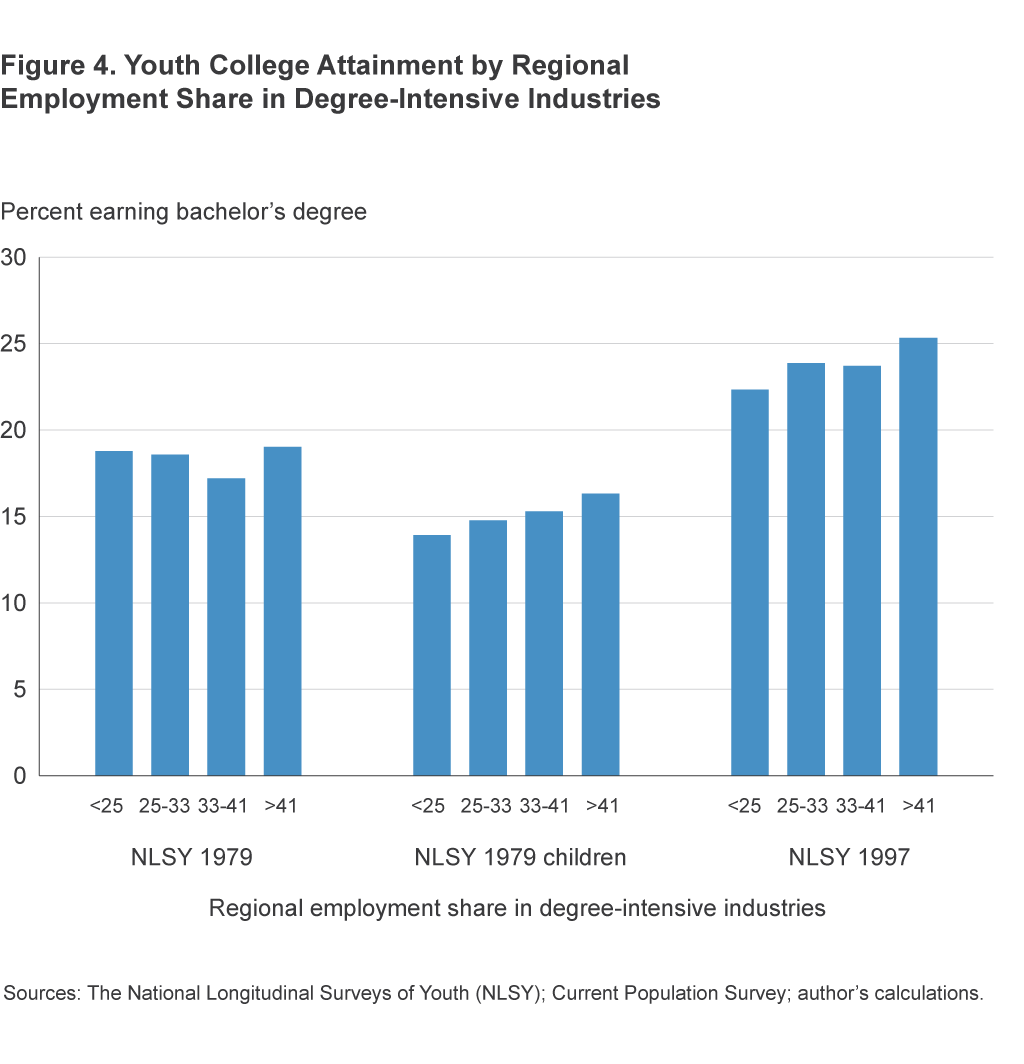
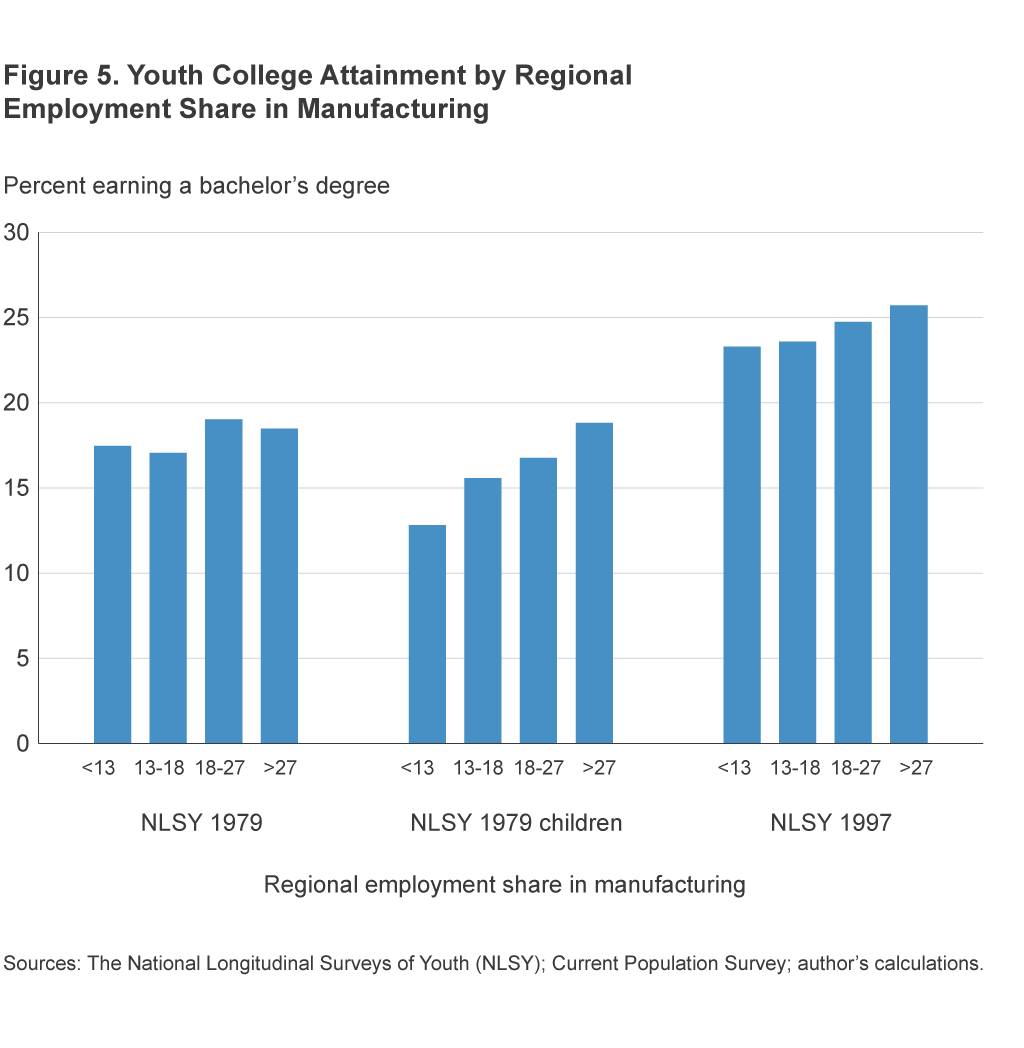
The finding of a positive relationship between manufacturing and college attainment for local youth is interesting because, in a snapshot of their work forces, manufacturing-intensive regions always have lower college attainment among their working-age adults. Economists have theorized that the high wages in factory jobs have lured young people out of school, causing the low attainment observed in such areas. The positive relationship between manufacturing and school completion suggests that manufacturing centers would have above-average educational attainment, unless later migration reversed it. As the children of nondegreed workers in manufacturing centers earn their degrees, they may migrate toward metro areas with growing degree-intensive industries. Also, workers without college degrees may gravitate toward manufacturing centers.
Interpreting the Results: Demographics or Features of the Labor Market?
Figures 2-5 show simple percentages of respondents who finished high school or college. We may wonder if the true cause of the differences in attainment could be some correlation of demographics and industry composition. Perhaps degree-intensive labor markets have more immigrants, or manufacturing centers have more high school drop-outs among their non-college-educated parents. We can use regression models to control for several demographics including mother’s age at birth, parents’ high school completion, immigrant status, siblings, gender and ethnicity, as well as time trends. In regression models with demographic controls, none of the patterns seen in the figures is eliminated or reversed.5 The stability of the patterns suggests that they are not driven by demographics or a coincidence of rising degree-intensive work, falling manufacturing, and rising degree attainment.
Alternatively, as discussed above, there are a variety of ways in which a high share of either manufacturing or degree-intensive industries could raise or lower educational attainment. Several possible channels through which these forces might influence educational attainment include sorting of parents by ability, household income, family formation, the local tax base, community norms of school completion, and returns to education. We can try to measure some of these factors using other variables in the NLSY and CPS data: household structure, incomes, and educational attainment of residents in the local labor market. Table 1 presents the correlations between the share of jobs in degree-intensive or manufacturing industries and a number of measures reflecting these channels.
Sources: The National Longitudinal Surveys of Youth (NLSY); Current Population Survey; author’s calculations.
| NLSY 1979 | NLSY 1979 children | NLSY 1997 | |||||
|---|---|---|---|---|---|---|---|
| Channel of impact | Measurement in the respondent’s local labor market at age 17 | Degree-intensive | Manufacturing | Degree-intensive | Manufacturing | Degree-intensive | Manufacturing |
| Return on investment in education | High school wage premium | .13 | −.11 | .21 | .03 | .16 | −.02 |
| College wage premium | .37 | −.01 | .33 | −.10 | .31 | −.11 | |
| Tax base for education funding | Median income | .53 | .08 | .61 | −.16 | .56 | −.07 |
| Community norms, career network | Share of adults with a high school degree | .64 | −.33 | .49 | −.24 | .45 | −.19 |
| Share of adults with a college degree | .91 | −.46 | .90 | −.43 | .91 | −.43 | |
| Share of adults who are currently undergraduate or graduate students | Not available | Not available | .43 | −.21 | .21 | −.17 | |
| Measurement in the respondent’s household during childhood | |||||||
| Investing in education | Income | .01 | .10 | .10 | −.06 | .03 | .05 |
| Parental time investments | Single parent | .08 | −.03 | −.00 | .01 | −.10 | .03 |
| Role model, career network | Working mother | .02 | −.03 | −.03 | .01 | −.01 | .04 |
| Nonworking father | −.01 | −.03 | −.01 | .01 | −.01 | –.05 | |
| Geographic sorting by ability | At least one parent has a high school degree | −.01 | .01 | −.01 | −.01 | .02 | −.01 |
None of the household measures is strongly correlated with either type of industrial composition. Among the other labor market measures, both high school and college degree attainment are positively correlated with jobs in degree-intensive industries. Undergraduate and graduate students are more common in areas with more degree-intensive work. The measures of median income and wage premia all have positive correlations with degree-intensive industries and smaller or negative correlations with manufacturing.
These correlations would be consistent with the idea that degree-intensive industries provide funding for local schools and wage premia that motivate local students to finish school. If the relationship between these measures and educational attainment is the same in all places, the correlations suggest we should see respondents finish high school and college less if they live in a manufacturing center. But, as noted, higher manufacturing shares appear to have a positive, or at least neutral, relationship with educational attainment.
When we add these measures into the regression model, most of the coefficients have intuitive signs and magnitudes, and they are often highly significant. However, none of the measures alone appears to explain the impact of manufacturing employment. Even when several of the most predictive variables are in the model, the positive relationship between manufacturing and high school completion remains large. When both household income and the indicator of having a single parent are included in the model, they seem to explain the influence of manufacturing on college attainment for the 1997 respondents. In the children’s survey, the positive relationship between degree-intensive employment and college attainment appears to be working through household income or regional median income. Including either income measure can explain the same variation as the degree-intensive industry measures.
Policy Implications
Several things can be taken away from this analysis of the NLSY data. Since the mid-1990s, the children of parents without a college degree are more likely to finish high school and college if they grew up in a labor market with a higher share of its jobs in manufacturing. The positive influence of manufacturing appears stronger for the more recent cohorts, but even during the early 1980s, there is no evidence that nearby manufacturing work discouraged students from finishing school. Growing up near degree-intensive industries is positively associated with the children of parents without undergraduate degrees earning college degrees among the children’s survey and the 1997 respondents. In contrast, growing up near degree-intensive employment is not associated with increased high school attainment for the children of parents without college degrees.
These findings, if they can be corroborated by other evidence, suggest that policymakers must consider another trade-off when pursuing economic development. For current workers without college degrees, state and local leaders can offer tax credits and other incentives to attract factories. Alternately, they can focus their recruiting and incentive spending on degree-intensive employers who will attract educated workers to the region and pay high salaries. The analysis here suggests that either of these approaches could increase the frequency of local children being the first in their family to finish college. If raising high school attainment is a priority, local leaders may need to direct more resources toward manufacturing. Living in a region with more manufacturing appears to support students in some way that enables more of them to finish high school rather than dropping out. In contrast, living in a region with more degree-intensive industries fails to provide the same advantages if the student’s parents do not have the degree to access the higher-paying positions in those industries. Further research is needed to fully understand how manufacturing supports high school completion while degree-intensive industries fall short.
Footnotes
- The calculations use the 1990 Current Population Survey industry classifications, which recognize 224 industries. Return to 1
- See, for example, Agtmael, Antoine W. van, and Fred Bakker, 2016. “The Smartest Places on Earth: Why Rustbelts Are the Emerging Hotspots of Global Innovation,” New York : PublicAffairs. Return to 2
- See, for example, Pacetti, Emily Garr. 2014. “Growth and Opportunity: A Framework for Stronger, More Equitable Local and Regional Economies,” The Fund for Our Economic Future. Return to 3
- This research was conducted with restricted access to Bureau of Labor Statistics (BLS) data. The views expressed here do not necessarily reflect the views of the BLS. Return to 4
- These results are available in the online appendix. Return to 5
For Further Reading
- Whitaker, Stephan, 2020. "Industrial Composition and Educational Intergenerational Mobility," Federal Reserve Bank of Cleveland, Working Paper no. 15-33R.
Suggested Citation
Whitaker, Stephan D. 2016. “Manufacturing or Degree-Intensive Labor Markets: Where Do the Children of Non-College Graduates Earn More Degrees?” Federal Reserve Bank of Cleveland, Economic Commentary 2016-12. https://doi.org/10.26509/frbc-ec-201612
This work by Federal Reserve Bank of Cleveland is licensed under Creative Commons Attribution-NonCommercial 4.0 International





